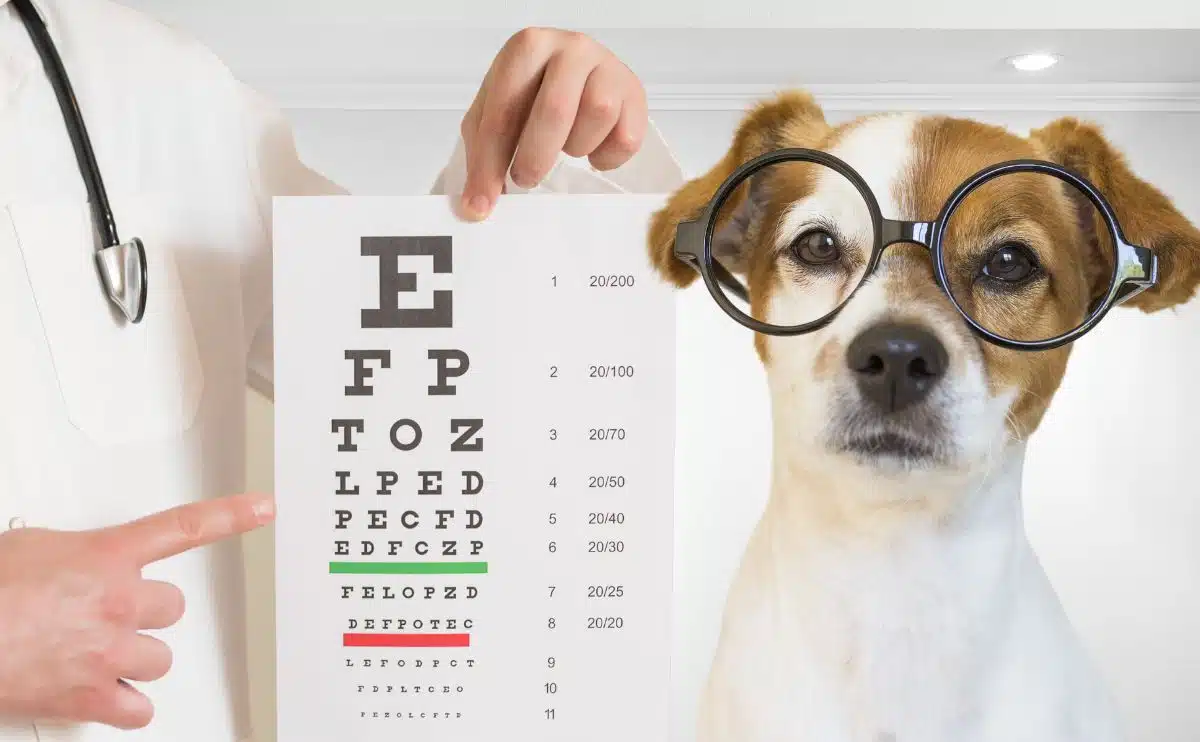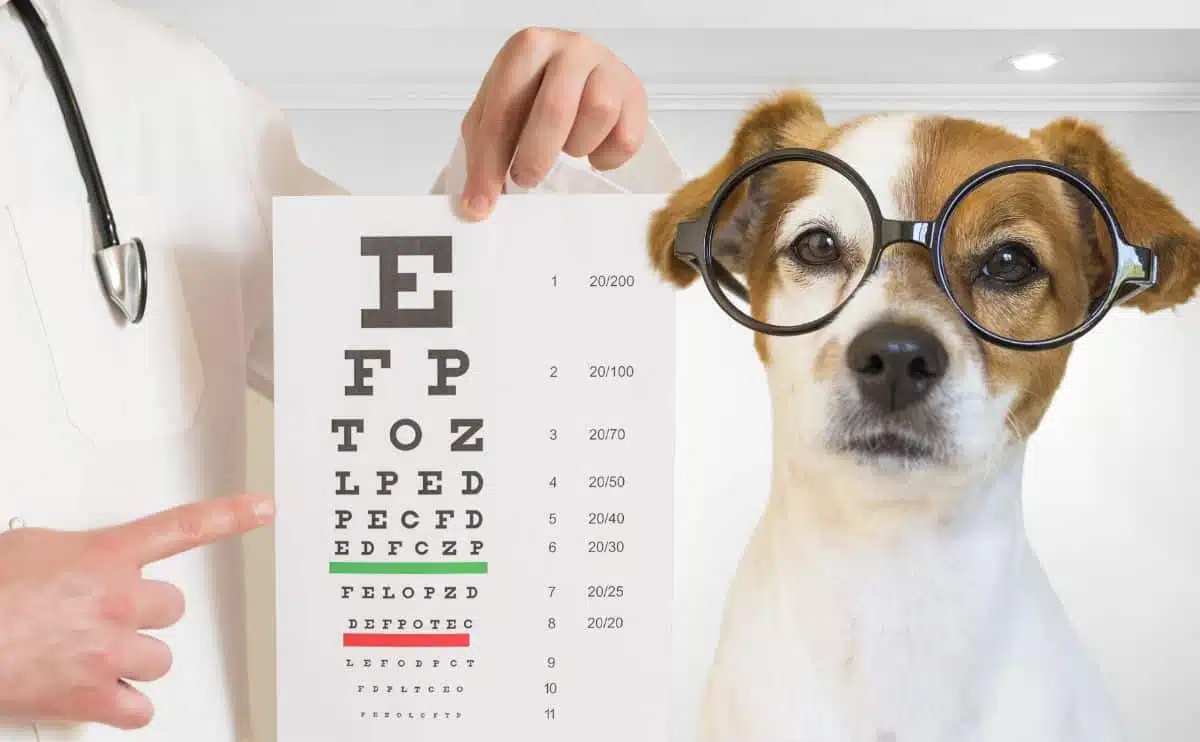
To keep the lights on, we receive affiliate commissions via some of our links. Our review process.

Because a dog’s sense of smell is far more powerful than humans, you might think that our furry friends also have a leg up on us with their ability to see. But when it comes to sight, we generally have the upper hand. So, you’re likely wondering, what does a dog’s vision look like? How different is it from ours? We shed light on what dogs can and can’t see, how to spot signs of vision loss in your pup, and more.
Dog Vision vs Human Vision
Contents
While our dogs’ eyes share many similar anatomical features as humans, some significant differences affect how and what dogs see. These structural variations include:
- Both humans and dogs have two types of light-sensitive cells in their retinas, called rods and cones. Dogs have fewer cones but more rods than humans. These differences affect motion detection, color visualization, and seeing in lower light, which we explain in more detail below.
- Pupils (the black circle in the iris) regulate how much light enters the eye. They contract (get smaller) in bright light and dilate (get bigger) in low light. Canines’ pupils are capable of dilating to a larger diameter than ours can, which gives dogs better vision in dim light.
- Unlike humans, many dog breeds have a tapetum lucidum located behind the retina. This layer reflects light back across the retina, which gives canines (and other animals like cats) better night vision than humans.
- Most dogs have a wider field of view (peripheral vision) because their eyes are set farther apart than humans, which face straight forward.
- Canines, especially those with wider set eyes, have less depth perception than we do. This is because greater peripheral vision compromises binocular vision (where the field of view of each eye overlaps). Good depth perception relies on binocular vision.
How Do Dogs See The World?
So how do these anatomical variations affect dog vision when compared to human vision? Here’s how dogs see the world when it comes to colors, visual acuity (sharpness), detecting movement, and night vision.
How Far Can Dogs See?
Dogs don’t see details or distant objects nearly as well as humans. While normal human visual acuity is 20/20, most dogs’ eyesight is 20/75. This means that an object a dog can barely recognize at 20 feet away is clear enough for a person with normal vision to identify at a distance of 75 feet. However, there are exceptions with some breeds. For example, Labrador Retrievers have closer to 20/20 vision, which, in part, explains why they’re commonly used as seeing-eye dogs for humans.
How Good Is A Dog’s Motion Detection?
Canines compensate for what they lack in visual acuity with a better ability to detect motion. That’s because they have more rods in their retina than we do. Rods are sensitive to movement (and lower light conditions). Having more rods means that dogs can see about 80 images per second compared to humans’ 60 images per second.
So, while dogs can’t distinguish details of distant objects as well as us, they can see distant movements better than humans (they just may not be able to tell what it is that’s moving). Our furry friends are also extremely adept at detecting even the smallest changes in our body posture.
Can Dogs See Color?
Yes, dogs can see some colors, but their world isn’t nearly as vivid as ours is. Unfortunately, canines only have the ability to see shades of blue, yellow, and gray. Dogs aren’t able to recognize green, red, and orange. Canines also don’t see colors as brightly as we do. These differences occur because humans have many more cones in their retinas than our canine counterparts. Cones are sensitive to color and vision sharpness. Learn more about how dogs see color.
Can Dogs See In The Dark?
Dogs can see better in lower light due to several structural advantages over humans. These include rod-dominated retinas, larger pupils that let more light in, and the tapetum lucidum, which reflects light back across the retina. However, dogs are similar to humans in that they can’t see well in pitch-black conditions. Learn more about canine night vision.
How Do I Know If My Dog’s Vision Is Deteriorating? A Vet Explains
We contacted Hannah Godfrey, BVetMed, MRCVS, a small animal veterinarian at Bridges Veterinary Surgery in Cardiff, Wales, to share signs of vision loss in dogs that owners should be aware of and her experiences with her canine patients.
“If your dog starts bumping into things, seems more tentative when moving around, or struggles in low light, he might have vision loss,” she explains. “Sometimes, vision loss can occur in an eye that looks completely normal. But sometimes there may be a visible abnormality like a cataract, excessive inflammation, or bulging of the eye.”
How Do Vets Perform An Eye Exam?
It’s not nearly as easy to measure vision loss in dogs as it is in humans because our canine companions can’t read an eye chart. Godfrey shares her diagnostic approaches. “When I check a dog for vision loss, I first check that their pupils respond to light the way that they should. Then I check that they respond to my hand coming toward their eye by blinking, flinching, or turning away (known as the menace response).”
Godfrey also uses a scope to look at the back of the eye (the retina) to check that the structures and blood vessels look normal. “Then I have to get a bit creative”, she says. “It’s not unusual to see me setting up a small obstacle course in my room or dropping objects like cotton wool from above a dog’s head to see if they follow it!”
“I remember one case in particular, a Labrador, where the owner brought him to me because he was suddenly reluctant to walk at dusk, even on the usual route that they’d been doing for years,” Godfrey shares. “The owner didn’t think he could be losing his vision because he didn’t bump into anything at home. However, this isn’t uncommon, as dogs can cope very well with poor vision in a familiar, enclosed environment like their home. I diagnosed the dog with immature cataract formation and referred him to an eye specialist for assessment and surgery. His vision recovered fully, which was excellent.”
Common Dog Eye Problems
Because many underlying conditions can cause vision loss, it’s essential to contact your veterinarian as soon as you suspect your pup may be having problems with her sight. Learn more about dog eye diseases, including conjunctivitis and uveitis. And check out this article about dog goggles and protective eyewear for ways you can protect your pup’s eyes when you’re on outdoor adventures.